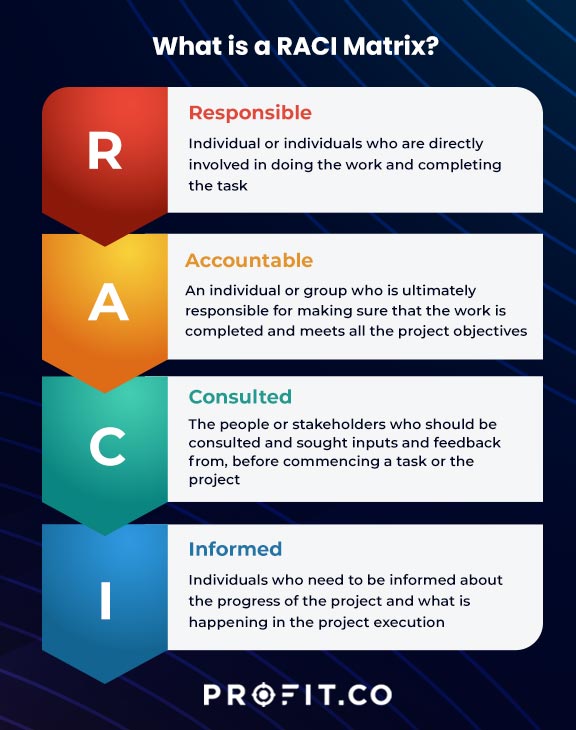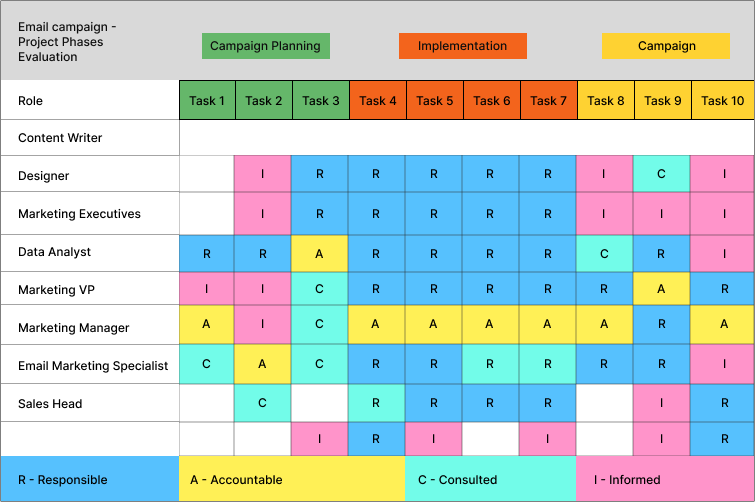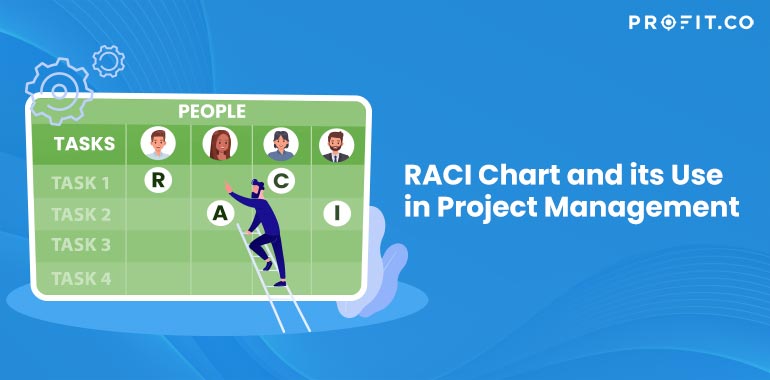Project management is a vital component of an organization’s success. However, it is not easy, as it involves so many individuals with diverse responsibilities; bringing them all together and aligning them to their roles to get the job done is a challenge. They all individually play a different part in collectively achieving various tasks and achieving the objectives of the project. As a result, they almost always have to interact with one another as individuals or teams to seek support and cooperation for a task, consult an expert, build teamwork and get the job done together. They have to report the project developments to their superiors and may need approval from someone at the top of the hierarchy.
All these complex interactions are indispensable for the smooth progress of the project. So attaining success requires a uniform understanding of who is responsible for which tasks or deliverables or decisions so that everyone knows whom to contact or report to on any given day for any given task.
For that, the roles and responsibilities in a project need to be clearly laid down, their involvement should be properly defined, and all that should be shared amongst the stakeholders involved in the project. Otherwise, employees constantly search for the right person responsible for a particular task or outcome. There is also a danger of involving people who are not responsible or capable of completing a particular task.
To avoid these confusions and to position the project for success, there is a need to communicate role distinctions to every employee involved. It is carried out by a tool called the RACI chart.
What is a RACI chart?
RACI is a Responsibility Alignment Matrix that clarifies team members’ roles and responsibilities and their level of involvement in every task, deliverable, milestone, or decision at every phase of a project. It is a visual tool – a simple table or diagram – created by project managers at the early stages of a project. It acts as a complete visual guide of who is responsible, accountable, consulted with, and informed for every task, milestone and decision throughout the various phases of the project. The RACI chart gives a complete overview of the key activities and deliverables for the project and maps each of them to the responsible individuals or teams.

RACI – Acronym stands for:
- Responsible
- Accountable
- Consulted, and
- Informed
In a RACI chart, each of the letters in the acronym denotes the type of responsibility assigned to a particular employee or a job title. Each one denotes a different level of responsibility and involvement concerning every task or outcome or deliverable. For instance, if there are 100 tasks in a project, every employee may have a different level of involvement in each. So, depending on the task, the letters assigned to every person vary.
Responsible
An individual who is marked as ‘responsible’ is the one who is directly involved in doing the work and completing the task. The RACI chart does not distinguish who does a task to its completion and who supports/participates in it.
For instance, in a software project, people who are ‘responsible’ could be programmers, software architects, project managers, etc. However, the programmers are the ones who usually write codes and technically complete the project; a software architect may involve mainly in ideation, and a project manager would be mainly overseeing and managing the progress of the project. But all these roles are marked as ‘responsible’. A person marked as ‘responsible’ may be involved in more than one task.
Accountable
An individual or group who is marked as ‘accountable’ is the one who is ultimately responsible for making sure that the work is completed and meets all the project objectives. It can be a decision-making authority or a stakeholder who finalizes a task, signs off the project or approves a decision to its completion. For every task or decision or deliverable, only one person/group can be marked as ‘accountable’. Having more than one person or group accountable can cause confusion. An ‘accountable’ person or a group can be the chairman of a business, a business owner, important stakeholders, a governance body such as the managerial board, etc.
Consulted
Those marked as ‘consulted’ are the people or stakeholders who should be consulted and sought inputs and feedback before commencing a task or the project. They will thoroughly look into the deliverables, analyze them and give feedback so they can be honed, fine-tuned and reinforced.
They can be experts in the concerned discipline or someone who verifies compliance with the project technically or legally, or Subject Matter Experts (SMEs) from whichever area or department might impact the task or the project in the future. The ‘consulted’ parties make sure that all the project requirements, challenges and risks are identified before initiating the project and that every aspect of the project outcomes is thoroughly analyzed at the end of the project.
The developments in the project are always communicated to the ‘consulted’ parties. For instance, if you are developing an e-commerce store, the ‘consulted’ parties concerning user data on the site would be the data privacy and legal experts, who could give their expert opinion on how you should go about collecting data and safeguarding them, and how to achieve compliance to the rules and regulations of the countries in which you operate.
Informed
Those marked as ‘informed’ are the individuals who need to be informed about the project’s progress and what is happening in the project execution. However, they are not directly involved in the execution of the project, and they do not have the same kind of responsibilities as those involved in it. As a result, they need not be given every minute detail about the project execution; they can be given an overall picture of how the project is progressing. They are usually part of the regular communication about the project update. This is to make sure that they are aware of what is happening.
For instance, if you are developing a new product, you can designate Heads of other products in the portfolio as ‘informed.’
Book a free demo with our team to learn more about how OKR software can optimize your organization’s performance!
Importance of the RACI chart
A RACI chart is important because:
- It is crucial for kickstarting the human resources planning of the project – mapping roles and responsibilities to various aspects of a task or outcome helps to identify any gaps in the human resources even before a project would commence so that the HR can recruit suitable people to fill in those gaps.
- Defining roles and responsibilities helps to implement a communication plan and establish governance.
- It ensures the smooth progress of the project, as it lets everyone understand down to the detail who is responsible for what, without having to ask those questions to team members and search for concerned stakeholders at any given time.
- It ensures clear communication and smooth workflows across teams and hierarchies.
- It prevents confusion even when someone with the decision-making authority makes many changes halfway through the project without much consultation.
Management is nothing more than motivating other people.
When Should You Use a RACI Matrix?
A RACI matrix can be used for projects of all sizes, as clarification of roles is essential for even the smaller and short-term projects that are carried out by a small number of people. The need for a RACI chart gets greater as the project gets bigger, lasts for a longer duration and involves so many individuals, departments and teams.
RACI Matrix example
For example, when you are creating an email campaign, you may need a Content Writer to write the text content, a Designer to design the emails, Marketing Executives who can leverage a mailing list, segment users, and schedule emails to be sent to various segments of users, and a Data Analyst who can analyze the campaign data interpret the outcomes of the campaign. They are the ones directly involved in creating a campaign and executing it. They will be the ones to be marked as ‘responsible.’
The campaign needs to be approved by someone high in the hierarchy, such as a Marketing VP, who is more of an ultimate authority in the department, reviewing and approving any important task or initiative, such as this campaign. This person will be ‘accountable’ and ultimately answerable for the success or failure of the campaign and its outcomes.
Then you may need a Marketing Manager to look into the scope of the campaign, an Email Marketing Specialist to verify the messages that need to be communicated in the emailer to each group of users in the mailing list and a Software Consultant to guide the team on how to use the email marketing software effectively. They are the ones who will be marked as ‘consulted’.
Finally, the ‘informed’ group may Include the Sales Head who will be impacted by the marketing exercise’s outcomes. Though he/she does not play an active role in the marketing campaign itself, he/she needs to be kept informed so that he/she can prepare the sales team about how to convert the leads from the campaign that reach the sales funnel.

Download RACI Template – Download
But this is merely a simple example; marketing campaigns are short-term projects involving a very small number of employees. However, when the project gets bigger, such as creating a new software product, it will involve a lot more employees, decision-makers, experts and stakeholders and will have much more complexity in identifying who is who in the project. A RACI chart will be most suitable for such a project.
Advantages of using a RACI
By clearly defining roles and responsibilities, RACI matrix:
- Prevents employees from involving in activities beyond their defined roles and frees them from unnecessary burden.
- Stops the involvement of too many people in giving inputs and trying to steer the project in different ways.
- Creates a clear communication path for the team members so that they know when to communicate with whom for any given purpose.
- Keeps the stakeholders informed and involved so they can plan and prepare for the project’s outcomes that will impact their work.
Disadvantages of RACI
While RACI matrix has numerous advantages, it can also have some disadvantages.
- Creating a RACI chart and communicating it with concerned employees can consume time and resources, and the benefits it brings to the project may not be enough to justify creating it in the first place when the project is not big enough.
- Efforts should be made for employees to adhere to their roles specified in the chart; otherwise, it can be a complete waste.
- If there is no uniform understanding of the differences in levels of responsibility in each of the assigned roles in the RACI acronym, then it defeats the purpose of RACI. Employees need an orientation to the RACI matrix.
- In some cases, clearly defining responsibilities can be a disadvantage, considering companies are moving towards hiring skilled employees in more than just one type of work or discipline. Today, an employee is expected to go beyond the confines of the job description and contribute in a more versatile way. At this juncture, limiting the employees to certain responsibilities can be counterproductive, depending on the project and the nature of the organization.
How to create a RACI matrix
You can create a RACI Matrix by
- Taking an audit of the various tasks required for the successful completion of the project.
- List the tasks and deliverables chronologically in the order of completion on the left side of the chart.
- Make a list of all the stakeholders in the project and place them along the top row of the chart.
- Mapping the various levels of responsibility – R, A, C, and I and assigning them to every stakeholder according to their level of involvement in every task.
- Make sure that at least one ‘responsible’ person is assigned for every task.
- Ensuring that there is only one ‘accountable’ stakeholder for every task.
- Verify that every team member has a role in each task.
- Defining the RACI roles in a separate worksheet to create clarity and uniform understanding.
- Sharing the RACI model with all the stakeholders.
- Building consensus amongst the stakeholders and getting them to agree on the RACI model before the project commences.
RACI chart – Best practices
- Verify your RACI matrix and ensure that the responsibilities are allotted to the right people.
- Give an orientation towards the role assignments to all the stakeholders and onboard them before commencing the project, as uniform adaptation and understanding of the roles and responsibilities are crucial for the project’s success.
- Make sure that all the stakeholders agree to take up the RACI roles that you have assigned to them at each stage of the project.
- Avoid any confusion in allocating roles, and make sure that the RACI matrix clarifies everything and prevents potential misunderstandings in the future as the project progresses.
- When you list out the tasks, deliverables, milestones and decisions involved in the project, make sure that they are project-specific and important for the project, not generic and inconsequential like the weekly check-ins.
- Always attach the RACI role definitions as a supplement while sharing the chart so that everyone has a copy of it for quick reference in the future.
- When you do project planning, map the tasks in the chart to your project plan, so there is no confusion or misalignment.
FAQs
- What are the four components of RACI?
RACI stands for: Responsible, Accountable, Consulted and Informed
- What is a RACI project management?
The RACI project management model is used to manage projects that involve many stakeholders. It is done by clarifying the roles and responsibilities of team members and their level of involvement in every task, deliverable, milestone, or decision at every project phase.
- What task should be included in RACI?
Every task that is crucial for the completion of the project should be included in the RACI matrix.
Final Thoughts
Raci chart is a helpful tool in project management. The roles and responsibilities need to be clearly defined so that there is accountability from all the team members. RACI charts also allow a consultant to be involved and take feedback and ideas from them. The OKR software, a goal management platform, helps you define your objectives with measurable key results to help in project execution across the organization with alignment and transparency. Use an agile OKR software tool like Profit.co completely free today and experience the difference in your organization.

